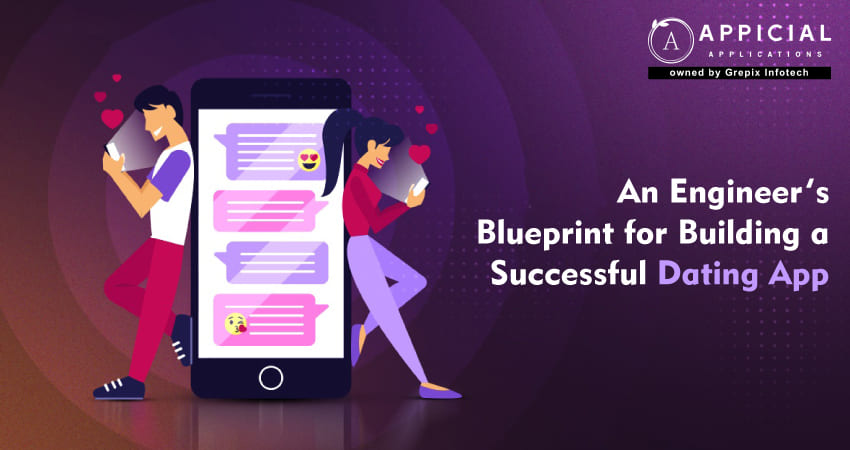
An Engineer’s Blueprint for Building a Successful Dating App
In today's digital age, dating apps have revolutionized the way people connect, form relationships, and find love. From Tinder's swipe-right simplicity to Bumble's women-first approach, dating apps have become an integral part of modern dating culture. However, with the plethora of options available, creating a successful dating app that stands out from the crowd requires more than just a unique idea. It demands a strategic approach, a deep understanding of user behavior, and a solid technological foundation.
For engineers, building a dating app presents a unique challenge that combines technical expertise with an understanding of human psychology and user experience. It's not just about writing code; it's about creating an engaging, safe, and enjoyable platform where users can connect meaningfully.
In this comprehensive guide, we will walk you through the essential steps and considerations for building a successful dating app development. From market research and core feature definition to design, development, and continuous improvement, this blueprint will equip you with the knowledge and tools needed to turn your vision into a thriving reality. Whether you're a seasoned developer or a tech enthusiast looking to embark on a new project, this guide is your roadmap to success in the competitive world of dating apps.Here’s a detailed blueprint for engineers to build a successful dating app.
Creating a successful dating app involves more than just coding; it requires strategic planning, understanding user behavior, and continuous improvement. This comprehensive guide for engineers covers essential steps, including market research, defining core features, designing an intuitive UI/UX, developing with a suitable tech stack, and implementing security measures. It also emphasizes the importance of thorough testing, effective marketing strategies, and post-launch support. By focusing on user experience and leveraging innovative features, engineers can build a dating app that stands out in the competitive market and fosters meaningful connections.
1. Market Research and Idea Validation
Understanding the Market
Before diving into development, it’s essential to understand the current dating app landscape. Analyze successful apps like Tinder, Bumble, and Hinge to identify what works and what doesn’t. Look for gaps in the market that your app could fill, whether it’s a niche audience or a unique feature.
Validating Your Idea
Once you have an idea, validate it through surveys, focus groups, or beta testing with a small group of users. Gather feedback on the concept, features, and overall appeal. This step ensures that there’s a demand for your app and helps you refine your idea before investing significant resources.
2. Defining Core Features
- User Profiles Creating detailed and customizable user profiles is crucial. Allow users to add photos, bios, interests, and preferences. The more personalized the profiles, the better the matches.
- Matching Algorithm Develop a robust matching algorithm that goes beyond simple location and age filters. Consider incorporating machine learning to improve match suggestions over time based on user behavior and preferences.
- Messaging System A seamless and secure messaging system is vital. Include features like read receipts, typing indicators, and multimedia sharing. Consider implementing icebreaker prompts or conversation starters to help users initiate conversations.
- Safety and Verification User safety should be a top priority. Implement profile verification processes such as photo verification or linking social media accounts. Additionally, include features for reporting and blocking users.
- Push Notifications Keep users engaged with push notifications for new matches, messages, and other important updates. Personalize notifications based on user activity to avoid being intrusive.
3. Designing an Intuitive UI/UX
- User-Friendly Interface Design a clean and intuitive interface that’s easy to navigate. Use familiar icons and straightforward language. The goal is to make the app accessible to all users, regardless of their technical proficiency.
- Onboarding Process Create a smooth onboarding process that guides users through profile creation and understanding app features. Use a combination of tooltips, tutorials, and progress bars to enhance the onboarding experience.
- Gamification Elements Incorporate gamification elements to make the app more engaging. Features like swiping, badges, and achievement levels can increase user interaction and retention.
4. Developing the App
Choosing the Tech Stack
Select a tech stack that suits your app’s needs. Popular choices include:
- Frontend: React Native, Flutter
- Backend: Node.js, Django, Ruby on Rails
- Database: MongoDB, PostgreSQL, Firebase
Building a Minimum Viable Product (MVP)
Start with an MVP to test your core features with real users. This approach allows you to gather feedback and make improvements before a full-scale launch. Focus on building a stable and secure app with essential features.
Implementing Security Measures
Protect user data with strong encryption and secure communication protocols. Regularly update your app to patch vulnerabilities and comply with data protection regulations like GDPR.
5. Testing and Quality Assurance
- Automated Testing Implement automated testing for your codebase to catch bugs early and ensure consistent performance. Use tools like Selenium, Appium, or TestComplete for comprehensive test coverage.
- User Testing Conduct extensive user testing to identify usability issues and gather feedback on the overall experience. Use A/B testing to compare different versions of features and optimize accordingly.
- Performance Optimization Ensure your app runs smoothly on various devices and network conditions. Optimize loading times, reduce battery consumption, and minimize data usage to provide a seamless user experience.
6. Launch and Marketing Strategy
- Pre-Launch Hype Build anticipation for your app through social media teasers, blog posts, and email newsletters. Collaborate with influencers and bloggers in the dating niche to reach a broader audience.
- App Store Optimization (ASO) Optimize your app’s listing on app stores with relevant keywords, engaging descriptions, and high-quality screenshots. Encourage satisfied users to leave positive reviews and ratings.
- Marketing Campaigns Launch targeted marketing campaigns on social media platforms, search engines, and dating forums. Utilize both organic and paid strategies to attract users. Offer promotions, such as free trials or premium features, to incentivize sign-ups.
7. Post-Launch and Continuous Improvement
- Gathering User Feedback Continuously collect feedback from users to understand their needs and pain points. Use in-app surveys, reviews, and customer support interactions to gather insights.
- Regular Updates Keep your app relevant and competitive with regular updates. Introduce new features, fix bugs, and enhance security. Communicate updates to users through release notes and notifications.
- Analyzing Data Leverage analytics tools to monitor user behavior, engagement metrics, and conversion rates. Use this data to make informed decisions about feature improvements and marketing strategies.
- Community Building Foster a sense of community among your users by creating social media groups, forums, or in-app communities. Engaged users are more likely to stay loyal and recommend your app to others.
8. Monetization Strategies
- Freemium Model Offer a basic version of your app for free while providing premium features for a subscription fee. Premium features could include advanced filters, unlimited swipes, or profile boosts.
- In-App Purchases Allow users to purchase virtual goods, such as profile boosts or special messaging privileges. This model works well in conjunction with the freemium model.
- Advertisements Integrate ads carefully to avoid disrupting the user experience. Offer an ad-free version as part of your premium subscription to cater to users who prefer an uninterrupted experience.
Also Read: How Mobile App Solutions Drive Digital Transformation Forward
Benefits of Using Our Dating App Software Development
1. Customizable Solutions
Our dating app software development services offer highly customizable solutions tailored to your specific needs and target audience. From unique design elements to specialized features, we ensure your app stands out in the competitive market.
2. User-Friendly Interface
We prioritize creating an intuitive and visually appealing user interface that enhances user experience. Easy navigation and attractive layouts keep users engaged and satisfied with the app.
3. Advanced Matching Algorithms
Our intelligent profile-matching algorithms increase the likelihood of successful connections by considering users' preferences, interests, and behaviors. This leads to more meaningful matches and a higher rate of user satisfaction.
4. Robust Security Measures
We implement stringent security protocols to protect user data and ensure a safe dating environment. Our apps include features like profile verification, encrypted messaging, and options for reporting and blocking users.
5. Scalability and Performance
Our dating apps are built to handle growing user bases and increased activity. We use scalable architecture and performance optimization techniques to ensure your app runs smoothly, even during peak times.
6. Cross-Platform Compatibility
We develop apps that are compatible across multiple platforms, including iOS and Android. This broadens your reach and allows you to cater to a diverse user base.
7. Continuous Support and Maintenance
Our commitment doesn’t end at launch. We provide ongoing support and maintenance services to keep your app up-to-date with the latest features, security updates, and performance enhancements.
8. Innovative Features
Stay ahead of the competition with innovative features such as video profiles, virtual gifts, in-app events, and more. These features not only enhance user engagement but also offer unique ways for users to connect.
9. Data-Driven Insights
We integrate analytics tools to provide you with valuable insights into user behavior and app performance. These data-driven insights help you make informed decisions about future updates and marketing strategies.
10. Expert Team
Our team of experienced developers, designers, and project managers work collaboratively to deliver high-quality dating app solutions. We bring a wealth of knowledge and expertise to every project, ensuring your app’s success.
Conclusion
Creating a successful dating app is a multifaceted endeavor that combines technical expertise, market insight, and a deep understanding of user behavior. From the initial stages of market research and idea validation to the intricate details of design, development, and continuous improvement, every step plays a crucial role in shaping a standout dating platform.
By focusing on user experience, implementing robust security measures, and staying attuned to market trends, engineers can develop a dating app that not only attracts users but also fosters meaningful connections. The journey involves constant iteration and adaptation, leveraging user feedback, and incorporating innovative features that keep users engaged and satisfied.
Ultimately, the key to success lies in balancing technical sophistication with a user-centric approach. By adhering to this blueprint, you can build a dating app that not only thrives in the competitive market but also helps people find genuine connections and love. Embrace the challenge, and let your engineering expertise pave the way to creating a revolutionary dating app that stands the test of time.
Launch your vision with our mobile app development company, where innovation meets excellence to create cutting-edge mobile solutions."







